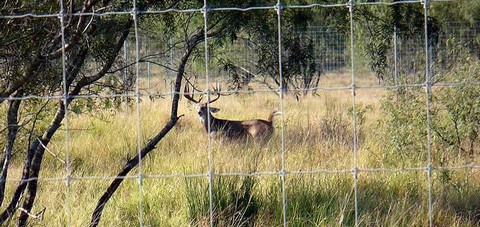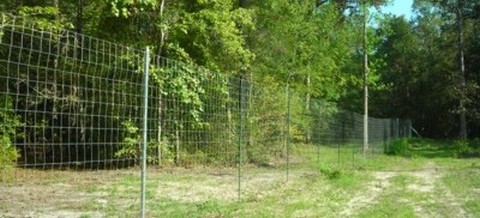Question: “Our family has over 600 acres down in South Texas. We have federal property along the east border, an industrial facility to the west and some trigger happy neighbors to the south. We are in the final stages of negotiating the cost of a pipeline running along to borders of the ranch. The money paid will more than cover the cost to high fence the perimeter of the property, which the entire ranch needs new fencing regardless.
We are meeting with some other local landowners with high fenced properties to discuss the pros and cons and hopefully answer a lot of questions regarding managing whitetail deer and a few exotic animals. Assuming we high fence our property, what are your thoughts on what to do with the existing deer population as it relates to bringing in some better quality deer? How should the hog population be addressed both before and after high fencing?
Thanks for the input and helpful articles I have found thus far.” — Submitted by Chris. D.

High Fence Considerations
First, what are your goals? Second, what are your goals for the land? Will constructing a high fence around the property help you achieve these goals? These are important considerations for anyone pondering the placement of a game fence around their property in the name of deer management. In this particular case, the property needs new fencing so the timing is right (and the money is available), but consider the short-term and long-term goals for the property before building that really tall fence around it. Consider everything about the property (more on this later), not just the deer herd.
Most landowners will cite increased control, management over the deer herd as their primary reason for putting a high fence around a property. But, I can assure you that there have been many high fences built ONLY because of “trigger happy neighbors.” It’s only after the fence is complete that many landowners find themselves fenced in, only now in the role of a full-time deer manager. A high fence provides a landowner with the potential to manage deer density, buck to doe ratio and buck age structure, as well as the habitat found on the property (by manipulating deer numbers), but are you ready?
Committing to the Fence
It’s a commitment. Anyone that builds a high fence around a property should understand that they are taking full responsibility for the well being of the habitat and wildlife found within. It’s essentially a marriage between the owner(s) and the property. And much like having a significant other, there are going to be costs associated with taking care of a high fenced property, in terms of both time and money. How much time will a high fence mean to you?
It depends on the size of the property, but like any fence, expect to spend time checking the fence regularly and maintaining the fence as needed. There will be necessary repairs caused by falling trees, running water at draws and creek crossings, as well as those caused by feral hogs, deer and domestic livestock on either side of the fence. A fence of any size takes time and money to maintain, but a high fence constructed for the purposes of managing a deer population takes even more monitoring because of predator issues and the fact that any breech means animals will enter/exit.
High Fences are Not “Deer Proof”
Ask anyone that owns property surrounded by a high fence (or adjacent one) and they will tell you that deer get out. On the flip side, deer also get in. For all the reasons listed above, anything that compromises the integrity of the fence will allow animals to move on or off the property. Although the owners/managers of high fenced properties realize this, I think it’s important to mention for those considering constructing a high fence around their property. High fences are not deer proof; they’re more like deer retardant.
Whitetail deer found within habitat that provides the food, cover and water that they need will make a content living. However, deer also need a certain amount of space. This can vary greatly based on the habitat and conditions under which they live, but white-tailed deer naturally cover an area (home range size) that is a minimum of several hundred acres in size. For this reason, as well as others, it’s not recommend that properties less than several hundred acres in size be enclosed within a high fence. Larger acreages will help with deer “proof-ness.”
Predator Control is Important
Another critical component of managing a white-tailed deer population within a high fence is predator control. No one must be more committed to predator control, specifically coyotes, that a person that owns a high-fenced property. Why, you ask? Because a high fence, which limits the movement of whitetail, can and will be used by predators to make them more effective hunters of deer. Coyotes are smart animals and can take advantage of terrain, fences and use pack-hunting to systematically pick off a deer population, especially within small high fenced properties.
Even on large acreage properties, strange boundary configurations essentially create “death traps” for deer. These traps can be characterized as either property “fingers” or a fence corners. A finger would be a section, say 20-80 acres, that juts off the main body of the high fenced property, so it essentially forms an alley where deer can be pushed, run down and killed by coyotes. Corners are obviously bad for deer, good for coyotes. Avoid fencing fingers, which also reduces corners.
I’m not an all-out coyote hater, but if you have or plan to have a high fenced property where the goal is deer population management then this is something to be aware of. By the way, coyotes also use low fences (net wire) to increase hunting efficiency. Most deer can jump a normal fence, but maybe not if its tired (from being pursued) or a fawn.
Feral hog populations should be eliminated, but this is almost impossible reduced on every property where deer management is important or agriculture takes place. Although wild hogs will occasionally find and eat deer fawns, the larger problem will be the holes that big hogs create within the perimeter fence. There’s always the chance that hogs from outside the fence will bust in, but it’s the hogs within the property that will compete with deer for food, water and space.

High Fence White-tailed Deer Management
Unless you already know that you can only live with bucks that look exactly like those found in commercial deer breeder pens on your property, then please resists the urge to go out and buy them. It’s amazing what some good ole-fashioned management can do for a white-tailed deer population. Start with the things that a high fence allows you to control: deer density, buck to doe ratio and the age structure of bucks.
First, determine the carrying capacity of the property for white-tailed deer. This means getting a wildlife biologist on the property to determine how many deer the property can support based on the plant communities found there. Then, it’s a matter of conducting surveys in late summer or early fall to estimate the deer population and develop harvest recommendations based on goals.
This will likely include decreasing the doe population to get the number of bucks and the number of does closer together. On a 600 acre high fenced property, aiming for a buck to doe ratio of 1 buck for every 1.2 to 1.5 does would be a good place to start. This ratio can shift closer to 1:1 as the total number of bucks, percentage of older-aged bucks increases.
Maintaining proper deer density allows good nutrition for individual deer and that maintains a healthy whitetail herd. Healthy animals grow larger bodies and that translates into bigger antlers, higher fawn survival rates and better hunting year-in and year-out.
Selective, age-based buck harvest by shooting, for the most part, only bucks 5 1/2+ years of age will also increase the number of older-aged bucks in the herd. Older, well-fed bucks means substantial changes in antler quality can be observed without the introduction of deer.
Managing for the correct number of deer on the property is not only good for the deer (and the habitat that they require), but it helps your wallet too. The Supplemental feeding of deer works well when it’s part of a designed management plan, but do not think that you absolutely must provide high protein foods if the number of deer is at or below the carrying capacity of the property.
Deer, like people, will eat things that taste good when they are readily available, whether they really need it or not. Providing feed through genuine stress periods, of course, would be recommended.
One of the best things the owner of a high fenced property can do, or any property for that matter, is to prevent the deer population from exceeding the carrying capacity of the property. Just about every exotic ungulate competes with white-tailed deer, so the number of whitetail plus the number of exotics must not exceed the carrying capacity of the property. Also, keep cattle numbers at low to moderate levels if the primary interest is deer. Overgrazing leads to the overuse of the protein-rich foods that deer prefer, both forbs and browse plants.
Managing white-tailed deer within an enclosed area is a huge commitment. A high fence provides a landowner/manager with the ability to achieve deer management goals that may not have been otherwise possible, so this is why many see game fencing as such a valuable tool. On the other hand, a high fence is not for everyone. There are also the possibilities of no or mis-management by the property owner, which will negatively impact the deer herd, plant communities and likely value of the land.
High fencers are not real people.
To each their own is really how I live my life. This was a great article on high fence properties. There are huge financial considerations which makes high-fence operations not feasible for most of us working folks. Kirk Gibson and maybe David Cone did this up in northern Michigan next to my buddy. It really takes that kind of money to do this right. All properties are “fenced in” technically. It’s all an opinion on what is considered “free range”.